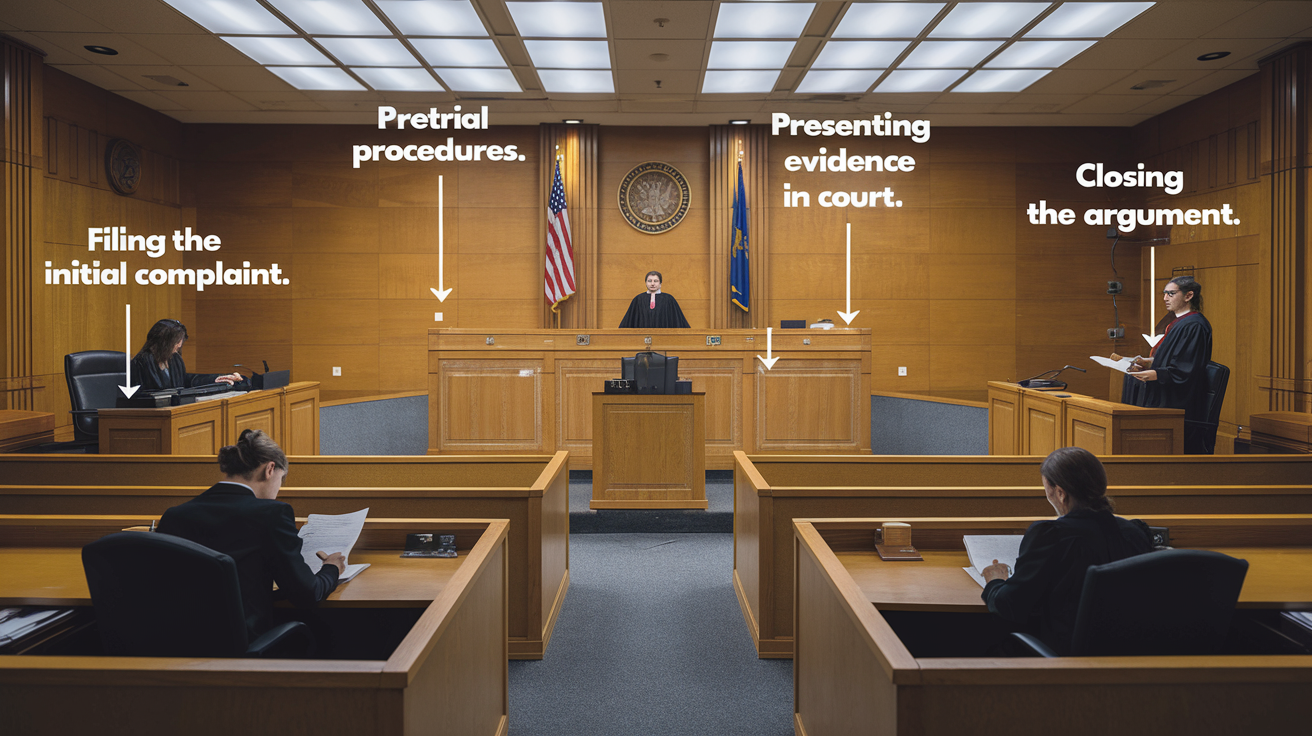It happened again. Your ex just lied under oath in family court.
Many parents feel helpless when faced with false statements during custody battles or divorce proceedings. The stress builds as you watch someone twist the truth, knowing it could affect your relationship with your children or your financial future.
People go through similar pain – the frustration of wanting to speak up but not knowing how to prove your case.
Here are practical steps to document and present evidence that exposes dishonesty in court. These methods have helped many parents protect their rights and ensure the truth comes to light.
Build a strong case that stands up to scrutiny using this blog.
Understanding the Nature of Lies in Family Court

Lying in family court is a serious issue that can have long-term consequences for all parties involved. Family law cases often involve personal matters, such as child custody, divorce settlements, and financial obligations.
Because these cases can profoundly impact people’s lives, deceit can affect the fairness and outcome of proceedings.
Types of Lies That Emerge in Family Court
Lies can manifest in various ways within family court proceedings. Some common types include:
- Exaggerations: These lies are not completely false but are presented in a way that inflates reality. For example, one might exaggerate their financial struggles to reduce alimony payments or child support.
- Omissions: This involves withholding critical information that would affect the case. A person might fail to disclose a hidden asset or income, which can significantly alter the case outcome.
- Blatant Fabrications: These lies are entirely made up, such as a false accusation of domestic violence or infidelity. Such fabrications are often intended to severely damage the other party’s credibility and sway the court’s judgment in one’s favor.
Recognizing these lies is essential to ensuring the family court system’s integrity and achieving a fair judgment.
Understanding the motivation and types of lies helps one prepare strategies to uncover deception effectively.
Identifying Signs of Deception

Detecting deception in family court can be challenging, as individuals may attempt to mask their dishonesty through well-rehearsed stories or deceptive body language.
However, by understanding key behavioral and verbal cues, it is possible to spot inconsistencies and assess the truthfulness of testimony.
Behavioral Cues of Deception
Behavioral signs can offer valuable insight into a person’s truthfulness. Deceptive individuals often exhibit noticeable changes in their body language or actions:
- Avoiding Eye Contact: While not always a clear indicator of lying, excessive avoidance of eye contact during questioning may signal discomfort or a desire to hide the truth.
- Nervousness or Restlessness: Fidgeting, shifting in the seat, tapping fingers, or excessive sweating are often signs of anxiety that may accompany dishonesty. Liars tend to exhibit these behaviors when they feel under pressure or when their story is shaky.
- Contradictory Movements: Sometimes, a person’s body language contradicts their words. For instance, someone may say they are calm and in control, but their tense posture or jittery hand movements suggest otherwise.
- Over-explanation: When someone lies, they may over-elaborate on details to make their story seem more believable. This often results in unnecessary information that doesn’t add value to the story and may give away the lie.
Verbal Indicators of Deception
In addition to behavioral cues, how someone speaks can also reveal deception. Here are some common verbal indicators to look out for:
- Inconsistent or Changing Stories: If a person provides different versions of events over time, it is a strong indication that they are fabricating details. A truthful individual is more likely to provide a consistent account of events, whereas a liar may struggle to maintain the same narrative.
- Vague or Evasive Responses: Liars often avoid giving direct answers and may try to divert the conversation or provide ambiguous responses. When asked specific questions, a deceptive person might offer generalities or try to change the subject.
- Excessive Detail or Overconfidence: On the flip side, some liars may provide an overwhelming amount of detail or speak with excessive confidence to appear credible. While this might seem convincing, the excessive detail can serve as a red flag. A truthful person will typically stick to the facts, while a liar might add irrelevant or fabricated details to solidify their story.
Psychological and Physiological Cues
Some signs of deception go beyond body language and speech, touching on psychological or physiological responses. These include:
- Changes in Voice Pitch: When someone is lying, their voice may change pitch, becoming higher or strained due to stress. This may indicate nervousness or discomfort with their own words.
- Pauses and Delayed Responses: Liars may take longer to respond to questions because they are trying to think of a believable answer. Short or delayed responses can be a subtle sign that the person is not being truthful.
- Involuntary Facial Expressions: Sometimes, a person’s facial expressions can betray them. Subtle expressions, like micro-expressions of fear, guilt, or anger, may appear for a fraction of a second and reveal the person’s true emotional state.
Gathering Evidence to Support Your Claims

Strong proof makes all the difference when you need to show the court that someone isn’t telling the truth. While watching behavior can suggest dishonesty, real evidence tells the true story.
You’ll need different types of proof to build a solid case:
- Papers like bank statements and work records
- Digital items such as texts, emails, and online posts
- Stories from people who saw what really happened
- Videos or recordings that show the truth
For more complex situations, experts can step in to help. Money specialists might find hidden funds, while computer experts can spot changed files. Sometimes, mental health professionals add their knowledge about behavior patterns that matter to your case.
The key is bringing together all these pieces to show your point clearly. Each piece of evidence should connect directly to what you’re trying to prove. This creates a clear picture that helps the court see the truth when done right.
Remember: good evidence speaks for itself. Rather than just saying someone isn’t honest, you’re showing it with facts that can’t be denied.
Utilizing Legal Strategies in The Family Court Process

Proving dishonesty in family court requires a thoughtful and well-planned approach. Legal strategies ensure that lies are exposed and the truth is presented clearly and persuasively.
These strategies involve a combination of effective questioning, careful document management, and legal motions to compel the other party to provide truthful evidence.
Cross-Examination Techniques
Cross-examination is critical to uncovering contradictions in a witness’s testimony. Key techniques include:
- Repetitive Questioning: Asking the same question in different ways can expose contradictions.
- Impeaching Credibility: Highlighting prior false statements or contradictory actions can undermine the witness’s reliability.
- Discrediting Evidence: Challenging dubious documents or inconsistent testimonies can discredit the opposing party’s case.
Effective cross-examination forces the opposing party to address inconsistencies, demonstrating their lack of credibility.
Filing Motions to Compel
A legal tool that makes the other party show proof or follow requests when they refuse to cooperate.
- When the other party doesn’t share evidence, you can ask the court for a motion to compel
- The court can order someone to give you exact items or follow certain requests
- They might face serious results if they don’t follow the court’s order
Using Subpoenas
A legal paper that requires other people or organizations to provide proof or speak up about what they know.
- You can send these to banks, workplaces, or medical offices to get records
- These help check if someone is telling the truth about their claims
- When you need proof from places like schools or daycares, these papers can help
The Role of Technology in the Family Court Process
Technology has become a cornerstone in the modern family court process, offering new avenues to gather evidence, analyze behaviors, and substantiate claims.
Technology offers powerful tools to expose untrue statements in court. Think of it as three digital truth-finders working together:
- First, there’s the everyday trail we leave online. Your social media tells a story – from vacation photos to dinner check-ins, each post comes with a time and place stamp. If someone tells the court they stayed home all week, but their Facebook shows them at a beach resort, that’s pretty clear proof.
- Next comes the deep-dive detective work. Computer experts can examine phones and laptops to find deleted messages or changed documents. It’s like putting together a digital puzzle—they can spot fake papers or find hidden accounts that tell the real story.
- Finally, we have the unblinking eyes of cameras. From store security to traffic lights, these videos clearly show where people really go and what they actually do. When someone’s words don’t match what the camera saw, the truth comes out.
Together, these tech tools work like a fact-checking team. While social media tells the public story, forensics reveals the hidden details, and cameras provide proof that can be seen.
How to Navigate the Court Process

Navigating the family court process effectively is vital to presenting a compelling case.
The legal system has several steps that must be followed carefully, and understanding each stage allows a person to strategize and ensure that they are fully prepared to present their case.
Step 1. Filing the Initial Complaint
This first legal step tells your story to the court. It lists what happened and what you want the court to do about it.
- Write down each time the other person wasn’t truthful, with proof to back it up.
- Keep your facts clear and simple to read
- Include every important detail – you might not be able to add them later
Step 2. Pretrial Procedures
This phase lets both sides share proof and ask questions before going to court. It’s like putting all the cards on the table.
- Ask for papers that show the truth (money records, messages, important files)
- Question the other person under oath to spot when stories don’t match
- Use legal steps to make sure you get all the proof you need
Step 3. Presenting the Case in Court
This is your time to show the court all your proof. Think of it as telling a story with facts to back up every point.
- Show how the other side’s words don’t match their actions
- Bring in experts to explain complex proof
- Ask smart questions to point out when stories change
Step 4. Closing Arguments
It’s your final chance to tie everything together and remind the court of the most important points.
- Sum up the strongest proof you showed
- Point out the biggest conflicts in the other side’s story
- Explain why these facts matter for the final decision
Conclusion
Getting the truth recognized in family court takes careful preparation and documentation. This blog shows the essential steps to prove dishonesty – from gathering text messages to securing witness statements and working with professionals.
Remember, staying calm and organized makes the biggest difference in these situations. The court needs clear, factual evidence to make its decisions. Your role is to present this evidence effectively without letting emotions take over.
What’s next? Start collecting and organizing your evidence today. Take screenshots, save documents, and write down important dates and events.
If you need help, consider speaking with a family law attorney who can guide you through this process.
Share your thoughts or questions in the comments below. Your experience might help other parents facing similar challenges in family court.








